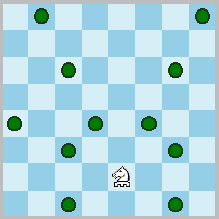

In Elkrider Chess "Elkriders" take the place of the Rooks. The Elkrider moves differently depending on the colour of the square. If positioned on a black square it moves like a Rook. If positioned on a white square it moves like a Nightrider: it can make continuous Knight jumps in the same direction, provided that the interim squares are empty. The Elkrider's value is 5, that is, the same as a Rook. Castling is performed with an Elkrider instead of a Rook. In regular chess the Rooks play a passive role in the first half of the game. The new Elkrider piece has part of the Rook's power, which can now be utilized early in the game. It is powerful enough to give mate to a lonely King. The Elkrider's image also changes when it moves to a square with a different colour (it rotates). This makes it easier to understand the piece.
The elk (amer. "moose") has actually been trained for battle service, in the cavalry of Charles XII of Sweden (1682-1718). Elks are much faster and more powerful than horses. However, it proved a time-consuming and costly task to train elks so the project was abandoned.
The Elkrider is a very interesting piece for the tactician. Positionally, too, it could be quite dangerous because one can sometimes sacrifice an Elk for a light piece (knight or bishop) to achieve positional ends. There is also a variant where Scorpions take the place of the pawns (see Scorpion Chess). Elkrider Chess can be played on a real board by using a Rook on the black squares, and turning it upside down on the white squares.
 The Elkrider, standing on a white
square, can jump like a knight, but
also has the continuous knight jumps.
On a black square it moves like a
rook.
The Elkrider, standing on a white
square, can jump like a knight, but
also has the continuous knight jumps.
On a black square it moves like a
rook.
• You can download my free Elkrider Chess program here, (updated 2006-07-18) but you must own the software Zillions of Games to be able to run it.
• Try playing Elkrider Chess by e-mail, against a human opponent, here.
• Don't miss my other chess variants.
© M. Winther 2006